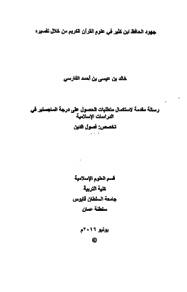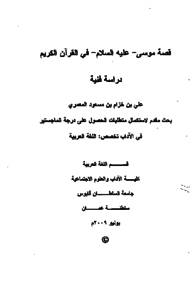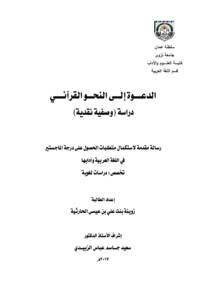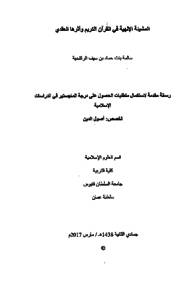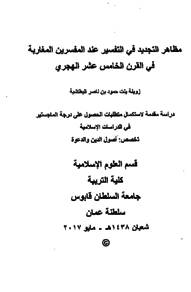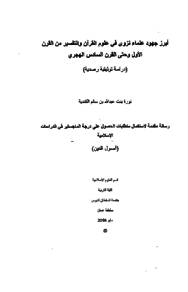Document
جهود الحافظ ابن كثير في علوم القرآن الكريم من خلال تفسيره
Publisher
جامعة السلطان قابوس
Gregorian
2016
Language
Arabic
English abstract
This research aims at collecting and highlighting the Qur'anic sciences involved in the interpretation of al-Hāfiz Ibn Kathir (may Allah have mercy with him). It aims at studying his contribution to this specialization. The research elucidates the environment in which Ibn Kathir lived, and how the learned environment influenced Ibn Kathir's personality as a scholar. The research introduces Ibn Kathir's vita, his descent and his rich scholarly activities.
The study is divided into ten sections. The first section talks about the life of Ibn Kathir and his interpretation of the Holy Quran, whereas the other nine sections study the Qur'anic sciences as spread throughout his in his Tafsīr.
The first of these sections focuses on the knowledge of Meccan and Medinese Qur'anic verses. Ibn Kathir studied these efficiently and presented a practical method to take advantage of this knowledge in his Tafsīr.
The second section is about abrogation (al-Naskh), which he studied deeply, and implemented it in his interpretation of the Holy Quran and linked it to other Qur'anic sciences.
He then discussed the incidents of revelation (Asbab al-Nuzül) and studied them in detail. Ibn Kathir said that the reasons behind revelation of verses of the Holy Qur'an must be authenticated in its narration to the Prophet or his Companions. He also required that the event must have taken place during the time of prophecy to consider it as a true reason for the revelation of the Holy Quran.
The next section is about the Muḥkam, the verses with clear indication or Mutashabiħ, the verses with ambiguous indication. Ibn Kathir linked these by returning the interpretation of verses with ambiguous meaning to those clear in meaning. The sixth section is about the Qur'anic readings (al-Qirā'āt), which has a significant presence in his interpretation and which benefitted him in different ways. His addition to the Qur'anic readings was significant as well as his discussion about the strange ones (al-qirā'āt al-shādhdhah). He linked al-Aħruf Al-Sabʻah, the seven letters, and benefitted from this to explain the historical compilation of the Holy Qur'an.
As for the last four sections, they were dealt with less extensively. Ibn Kathīr's interest was modest in al-Waqf, the places where people pause while reading the Holy Quran, and al-Ibtidā' the places where people start from, albeit its importance. He mentioned al-Waqf and al- Ibtida' only when he needed to in his interpretation to clarify the meaning of some Qur'anic verses. The same is true for the science of al-Wujūh and al-Nasā'ir, Qur'anic synonymous terms in different contexts. This science was less studied by Ibn Kathir than their predecessors of the Qur'anic Sciences. Ibn Kathir dealt with these in different places rather than collecting them in one place. As for the Mu'arrabāt, arabicised loan words in the Qur'an, he gave this topic the smallest share in his work.
Despite these, Ibn Kathir's presentation about was revealed first and last from the Holy Qur'an was moderate and supported by evidences and discussed the different dicta.
Member of
Resource URL
Arabic abstract
هدف هذا البحث إلى جمع وإبراز علوم القرآن الكريم المتضمنة في تفسير الحافظ ابن كثير - رحمه الله - ودراستها، ومعرفة ما أضافه الحافظ ابن كثير - رحمه الله - في هذا الفن. وقد بين البحث البيئة التي عاش فيها ابن كثير، وكيف أثر جوها العلمي في شخصية ابن كثير العلمية، من علوم حاضرة، وغزارة مشايخ، وتنافس في الطلب، وحضور للإبداع، وما إلى ذلك من مرتكزات علمية فنية وقد تم تقديم ابن كثير بالتعريف بشخصه، والنظر في مجريات حياته، والتعرف على نسبه، ومن ثم طلبه للعلم، ونشاطه العلمي الزاخر. وقد قسمت هذه الدراسة إلى عشرة مباحث ثم تخصيص المبحث الأول للحديث عن حياة ابن كثير وتفسيره، والتسعة الباقية لعلوم القرآن الكريم المبثوثة في تفسير ابن كثير، وكان البدء بعلم المكي والمدني الذي توسع فيه ابن كثير، وقدم منهجا عمليا في الاستفادة منه في التفسير، يليه مبحث النسخ الذي توسع فيه أيضا، ووظفه في تفسيره وربط بينه وبين علوم القرآن الأخرى، ثم عرض الباحث الأسباب النزول وتوسع فيه، وقد اشترط ابن كثير أن يكون مسنودا بنقل مرفوع، أو في حكم المرفوع، كما أنه اشترط أن يكون الحدث في زمن النبوة ليصح تسميته سببا للنزول، وأما المبحث الخامس فكان في المحكم والمتشابه، وقد كان ابن كثير فيه منضبطا بضابط رد المتشابه إلى المحكم، هذا الضابط الذي لم يحرمه في تفسيره، وسادس المباحث هو القراءات القرآنية الذي كان له حضور كبير في تفسيره، ونوع من استفادته به، وبرزت فيه إضافته الموجهة للقراءات، والمناقشة للشاذ منها، وربطها بالأحرف السبعة التي استفاد منها هي الأخرى في توجيه المسار التاريخي لتدوين القرآن الكريم أما المباحث الأربعة الباقية فكان التوسع فيها أقل، فالوقف والابتداء - على أهميته - كان اهتمام ابن كثير به متواضعا، وكان استخدامه له في تفسيره عند الحاجة لتفصيل المعنى وتوضيحه، وكذا علم الوجوه والنظائر التي كان نصيبه أقل من سابقيه من العلوم القرآنية. وقد ظهر عرض ابن كثير لها متفرقا عند كل وجه أكثر من جمعها في مكان واحد، وأما المعربات من الكلمات القرانية فقد بان في البحث أنها أقل العلوم المعروضة حصة من البروز
والإعمال والتوضيح، أما عرضه لأول وآخر ما نزل من القرآن الكريم فقد كان عرضا متوسطا مدعما بالأدلة، ومناقشا للأقوال المختلفة.
والإعمال والتوضيح، أما عرضه لأول وآخر ما نزل من القرآن الكريم فقد كان عرضا متوسطا مدعما بالأدلة، ومناقشا للأقوال المختلفة.
Category
Theses and Dissertations

